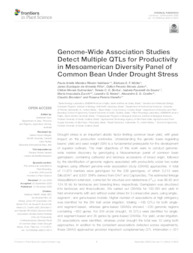Genome-wide association studies detect multiple QTLs for productivity in mesoamerican diversity panel of common bean under drought stress.
Genome-wide association studies detect multiple QTLs for productivity in mesoamerican diversity panel of common bean under drought stress.
Author(s): VALDISSER, P. A. M. R.; MÜLLER, B. S. F.; ALMEIDA FILHO, J. E. de; MORAIS JÚNIOR, O. P.; GUIMARÃES, C. M.; BORBA, T. C. O.; SOUZA, I. P. de; ZUCCHI, M. I.; NEVES, L. G.; COELHO, A. S. G.; BRONDANI, C.; VIANELLO, R. P.
Summary: Drought stress is an important abiotic factor limiting common bean yield, with great impact on the production worldwide. Understanding the genetic basis regulating beans? yield and seed weight (SW) is a fundamental prerequisite for the development of superior cultivars. The main objectives of this work were to conduct genome-wide marker discovery by genotyping a Mesoamerican panel of common bean germplasm, containing cultivated and landrace accessions of broad origin, followed by the identification of genomic regions associated with productivity under two water regimes using different genome-wide association study (GWAS) approaches. A total of 11,870 markers were genotyped for the 339 genotypes, of which 3,213 were SilicoDArT and 8,657 SNPs derived from DArT and CaptureSeq. The estimated linkage disequilibrium extension, corrected for structure and relatedness (r2sv), was 98.63 and 124.18 kb for landraces and breeding lines, respectively. Germplasm was structured into landraces and lines/cultivars. We carried out GWASs for 100-SW and yield in field environments with and without water stress for 3 consecutive years, using single-, segment-, and gene-based models. Higher number of associations at high stringency was identified for the SW trait under irrigation, totaling ~185 QTLs for both single- and segment-based, whereas gene-based GWASs showed ~220 genomic regions containing ~650 genes. For SW under drought, 18 QTLs were identified for single- and segment-based and 35 genes by gene-based GWASs. For yield, under irrigation, 25 associations were identified, whereas under drought the total was 10 using both approaches. In addition to the consistent associations detected across experiments, these GWAS approaches provided important complementary QTL information (~221 QTLs; 650 genes; r2 from 0.01% to 32%). Several QTLs were mined within or near candidate genes playing significant role in productivity, providing better understanding of the genetic mechanisms underlying these traits and making available molecular tools to be used in marker-assisted breeding. The findings also allowed the identification of genetic material (germplasm) with better yield performance under drought, promising to a common bean breeding program. Finally, the availability of this highly diverse Mesoamerican panel is of great scientific value for the analysis of any relevant traits in common bean.
Publication year: 2020
Types of publication: Journal article
Unit: Embrapa Rice & Beans
Observation
Some of Embrapa's publications are published as ePub files. To read them, use or download one of the following free software options to your computer or mobile device. Android: Google Play Books; IOS: iBooks; Windows and Linux: Calibre.
Access other publications
Access the Agricultural Research Database (BDPA) to consult Embrapa's full library collection and records.
Visit Embrapa Bookstore to purchase books and other publications sold by Embrapa.

